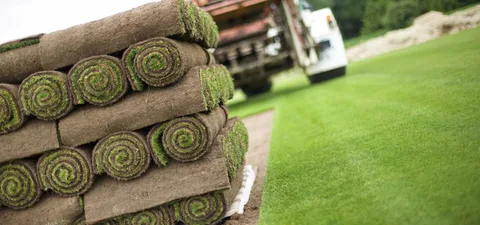A lush, green lawn is often considered the pride of any garden. Whether you’re a homeowner seeking curb appeal, a business aiming to impress visitors, or simply someone who enjoys spending time outdoors, having a well-maintained lawn makes a big difference. However, achieving and sustaining that healthy carpet of grass requires more than just occasional mowing. It calls for consistent attention, knowledge of seasonal needs, and sometimes, starting fresh with quality turf.
In this guide, we’ll explore the essential aspects of lawn care, from proper maintenance to when it makes sense to lay new turf. By the end, you’ll know exactly what steps to take to keep your outdoor space looking pristine year-round.
Why Lawn Care Matters
A well-kept lawn is more than an aesthetic choice. It brings several functional and environmental benefits:
- Improves Air Quality: Grass absorbs carbon dioxide and releases oxygen, making your outdoor environment fresher.
- Prevents Soil Erosion: A dense lawn holds soil in place and reduces runoff during heavy rains.
- Creates a Comfortable Space: A soft, green surface is perfect for children’s play, garden parties, or simply relaxing in nature.
- Boosts Property Value: Homes with healthy lawns are more attractive to potential buyers.
That’s why consistent Lawn maintenance is key. When you stick to a seasonal care routine, your grass not only looks better but also grows stronger and withstands stress from weather or foot traffic.
Seasonal Lawn Maintenance: Month by Month
Grass is a living, breathing part of your garden that changes with the seasons. To achieve year-round vibrancy, you need to tailor your care to each period.
Spring
Spring is the time for revival. As temperatures rise, your lawn wakes up from winter dormancy. Begin with:
- Scarifying: Remove thatch buildup and debris.
- Aeration: Loosen compacted soil to allow roots to breathe.
- Feeding: Apply a nitrogen-rich fertilizer for fresh growth.
Summer
Summer brings warmth and often drought stress. Key tasks include:
- Regular Watering: Especially during dry spells, ensure deep soaking rather than shallow watering.
- Mowing Smart: Avoid cutting grass too short; keep it slightly longer to protect roots.
- Weed Control: Stay on top of fast-growing weeds.
Autumn
Autumn is about preparation and repair. The cooler weather is perfect for:
- Overseeding: Fill in thin or bare patches.
- Fertilizing: Switch to a feed higher in potassium to toughen grass for winter.
- Leaf Clearing: Prevent piles of leaves that suffocate grass.
Winter
While grass growth slows, your lawn still needs care:
- Avoid Compaction: Limit walking on frosty or waterlogged grass.
- Keep It Clear: Remove debris and fallen branches.
- Plan for Spring: Winter is a good time to assess whether your lawn might benefit from a fresh start with new turf.
If you’re not sure what tasks to prioritize in a particular month, following a dedicated lawn maintenance guide ensures you never miss an essential step.
When to Consider Laying New Turf
Even with the best care, some lawns become too worn out, patchy, or weed-infested to revive. That’s when laying fresh turf is the most efficient solution.
Signs you may need to replace your lawn include:
- Persistent weeds that overtake grass.
- Bare, compacted areas where grass refuses to grow.
- Uneven ground caused by wear and tear.
- Desire for a completely new look in your garden.
Installing turf gives you an instant green lawn, transforming your garden almost overnight. And with proper aftercare, turf establishes quickly, providing a resilient, healthy lawn for years to come.
Choosing Quality Turf
If you decide to go down the turfing route, the quality of the turf you select will determine your success. Not all turf is created equal—look for rolls that are freshly harvested, free from weeds, and suited to your soil type and climate.
Thankfully, it’s easier than ever to Buy Turf online from trusted suppliers. By sourcing from specialists, you can be confident that your turf will arrive in excellent condition, ready to root into your garden soil.
Tips for Caring for Freshly Laid Turf
After laying your new lawn, the establishment phase is critical. Follow these guidelines to ensure success:
- Water Generously: For the first few weeks, water daily so the turf roots bond with the soil.
- Limit Foot Traffic: Avoid walking on the turf until it has rooted securely.
- First Mow: Wait until the grass reaches about 5–7cm before mowing, and only cut the top third.
- Fertilize Wisely: Use a balanced fertilizer to support strong root development.
Sustainable Lawn Practices
In today’s eco-conscious world, many homeowners want their lawns to be beautiful yet sustainable. Consider these practices:
- Rainwater Harvesting: Collect rainwater to irrigate your lawn.
- Natural Fertilizers: Use compost or organic lawn feeds instead of chemicals.
- Wildflower Borders: Blend traditional lawns with wildflowers to support biodiversity.
- Efficient Mowing: Keep blades sharp and mow less frequently to save energy.
Final Thoughts
A healthy lawn is the result of consistent care, seasonal adjustments, and sometimes, the decision to start fresh with high-quality turf. By following best practices and using reliable resources, you can enjoy a garden that not only looks stunning but also supports a healthier environment.
Whether you stick with routine lawn maintenance or decide to buy turf for a complete refresh, your efforts will reward you with a vibrant, inviting outdoor space to enjoy all year round.
